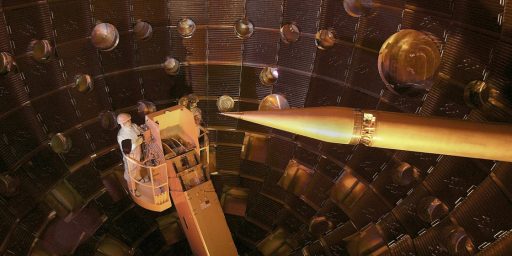New Elements for the Periodic Table
Via the BBC: New elements added to chemistry’s periodic table
Two new elements have been added to the periodic table after a three-year review by the governing bodies of chemistry and physics.
The elements are currently unnamed, but they are both highly radioactive and exist for less than a second before decaying into lighter atoms.
When I was a kid in science class, I always thought the idea of finding new elements to be quite cool (and still do, although perhaps not in the same way).
But, of course, the process does sound like a bunch of bureaucrats with Ph.D.s, doesn’t it? Who needs that?






I haven’t heard of any bureaucrats who were involved in this and the PhD’s are certainly from fields of real science, not the arts. People not only credentialed, but of actual accomplishment.
@jwest:
But how can you tell? They might be lying! Alinsky. Don’t forget Alinsky!
Indeed, I propose that one — if not both! — of the new elements be named after Alinsky. Perhaps Alinskmium and Saulanium.
I vaguely knew even back in junior high science days that any new elements would be of this sort–with such short half lifes as to be unsustainable. One wonders why we need to have such essentially theoretical elements on the table. What use do they have?
@James:
On the one hand, there is no doubt that one of the greatest political thinkers of the modern era deserve recognition, I fear that naming one of these elements after Alinsky would be problematic. Consider his overall staying power! He is no flash in the pan, but rather a durable figure for whom an element with such a brief half-life would be unworthy.
I believe James’ suggestions for the names have a chance of becoming reality.
The PhD’s who made the discoveries were probably in the fields of physics or chemistry, but as intelligent people they undoubtedly were well aware of Alinsky and his impact on U.S. politics.
If I recall correctly, scientists suspect that after a swath of short-lived heavier elements, there is going to be a swath of long-lived ones. What the properties of those elements are is hugely open to question, starting with whether they would be radioactive at all.
See Glen Seaborg’s Islands of Stability hypothesis.
But those buggers are going to be expensive…
“I vaguely knew even back in junior high science days that any new elements would be of this sort–with such short half lifes as to be unsustainable. ”
Well, then in view of the half-life of an original thought in jwest’s brain, I propose one be named Jwestium.
Random guesses:
Maybe someday we’ll be able to make them more stable, perhaps in some sort of different environment.
Maybe we’ll find a use for them that only requires them to exist very briefly. For instance, if they can be created, then react with some other substance.
It is in the spirit of TGs observations that I propose the names, PALINIUM and SANTORIUM.
Many of the particles in the standard model of physics have a half life on the order of a trillionth of second? Why bother naming such a thing?
Because in particle physics, lifespans in pico-seconds are common, and play a role in interactions that make up our everyday life (ie why the nucleus sticks together etc). What timescale is relevant depends upon what you’re studying.
In the case of the elements of the periodic table, even what seems to us a ridiculously short time scale is long enough for chemical properties to be displayed. In terms of engineering, there isn’t any use for those elements yet. But there wasn’t any use for electricity when Faraday first investigated it either.
I was hoping for Weinerium. I’d say Obamium, but he’s radioactive, lasts four years, (not seconds) and screws things up for decades.
Not too likely they’ll name it after politicians – scientists don’t tend to take politics any more seriously than politicians take science.
In fact, scientists in general tend to be about as interested in politics as politicians tend to be interested in science (ie almost not at all).
I agree Rodney, Bushium’s half life is WAY more than 3 years (11 years and counting) but it is stll as radioactive as ever.
See how easy this game is? And Rodney, I will play it with you any time, any where. You got my email. contact me.